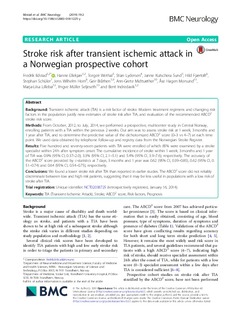Stroke risk after transient ischemic attack in a Norwegian prospective cohort
| dc.contributor.author | Ildstad, Fredrik | |
| dc.contributor.author | Ellekjær, Hanne | |
| dc.contributor.author | Wethal, Torgeir | |
| dc.contributor.author | Lydersen, Stian | |
| dc.contributor.author | Sund, Janne Kutschera | |
| dc.contributor.author | Fjærtoft, Hild | |
| dc.contributor.author | Schüler, Stephan | |
| dc.contributor.author | Horn, Jens | |
| dc.contributor.author | Bråthen, Geir | |
| dc.contributor.author | Midtsæther, Ann-Grete | |
| dc.contributor.author | Morsund, Åse Hagen | |
| dc.contributor.author | Lillebø, Marja-Liisa | |
| dc.contributor.author | Seljeseth, Yngve Müller | |
| dc.contributor.author | Indredavik, Bent | |
| dc.date.accessioned | 2019-04-10T06:11:45Z | |
| dc.date.available | 2019-04-10T06:11:45Z | |
| dc.date.created | 2019-01-23T21:11:26Z | |
| dc.date.issued | 2019 | |
| dc.identifier.issn | 1471-2377 | |
| dc.identifier.uri | http://hdl.handle.net/11250/2593918 | |
| dc.description.abstract | Background Transient ischemic attack (TIA) is a risk factor of stroke. Modern treatment regimens and changing risk factors in the population justify new estimates of stroke risk after TIA, and evaluation of the recommended ABCD2 stroke risk score. Methods From October, 2012, to July, 2014, we performed a prospective, multicenter study in Central Norway, enrolling patients with a TIA within the previous 2 weeks. Our aim was to assess stroke risk at 1 week, 3 months and 1 year after TIA, and to determine the predictive value of the dichotomized ABCD2 score (0–3 vs 4–7) at each time point. We used data obtained by telephone follow-up and registry data from the Norwegian Stroke Register. Results Five hundred and seventy-seven patients with TIA were enrolled of which 85% were examined by a stroke specialist within 24 h after symptom onset. The cumulative incidence of stroke within 1 week, 3 months and 1 year of TIA was 0.9% (95% CI, 0.37–2.0), 3.3% (95% CI, 2.1–5.1) and 5.4% (95% CI, 3.9–7.6), respectively. The accuracy of the ABCD2 score provided by c-statistics at 7 days, 3 months and 1 year was 0.62 (95% CI, 0.39–0.85), 0.62 (95% CI, 0.51–0.74) and 0.64 (95% CI, 0.54–0.75), respectively. Conclusions We found a lower stroke risk after TIA than reported in earlier studies. The ABCD2 score did not reliably discriminate between low and high risk patients, suggesting that it may be less useful in populations with a low risk of stroke after TIA. | nb_NO |
| dc.language.iso | eng | nb_NO |
| dc.publisher | BioMed Central | nb_NO |
| dc.rights | Navngivelse 4.0 Internasjonal | * |
| dc.rights.uri | http://creativecommons.org/licenses/by/4.0/deed.no | * |
| dc.title | Stroke risk after transient ischemic attack in a Norwegian prospective cohort | nb_NO |
| dc.type | Journal article | nb_NO |
| dc.type | Peer reviewed | nb_NO |
| dc.description.version | publishedVersion | nb_NO |
| dc.source.journal | BMC Neurology | nb_NO |
| dc.identifier.doi | 10.1186/s12883-018-1225-y | |
| dc.identifier.cristin | 1664028 | |
| dc.description.localcode | © The Author(s). 2019. Open Access. Attribution 4.0 International (CC BY 4.0) | nb_NO |
| cristin.unitcode | 194,65,30,0 | |
| cristin.unitcode | 194,65,35,5 | |
| cristin.unitcode | 194,65,15,0 | |
| cristin.unitcode | 194,65,20,0 | |
| cristin.unitname | Institutt for nevromedisin og bevegelsesvitenskap | |
| cristin.unitname | RKBU Midt-Norge - Regionalt kunnskapssenter for barn og unge - psykisk helse og barnevern | |
| cristin.unitname | Institutt for klinisk og molekylær medisin | |
| cristin.unitname | Institutt for samfunnsmedisin og sykepleie | |
| cristin.ispublished | true | |
| cristin.fulltext | original | |
| cristin.qualitycode | 1 |

